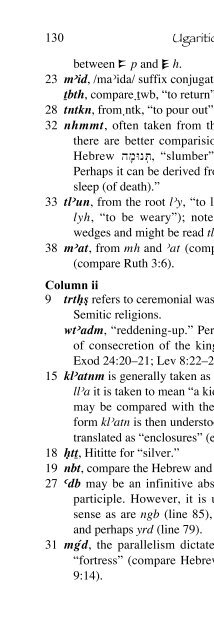A Primer on Ugaritic: Language, Culture, and Literature - enenuru
A Primer on Ugaritic: Language, Culture, and Literature - enenuru
A Primer on Ugaritic: Language, Culture, and Literature - enenuru
You also want an ePaper? Increase the reach of your titles
YUMPU automatically turns print PDFs into web optimized ePapers that Google loves.
130<br />
<strong>Ugaritic</strong> <str<strong>on</strong>g>Primer</str<strong>on</strong>g><br />
between p p <strong>and</strong> H h.<br />
23 m}id, /ma}ida/ suffix c<strong>on</strong>jugati<strong>on</strong>, 3ms, “he increased.”<br />
tbth, compare twb, “to return” or Hebrew tRbRv, “seat, thr<strong>on</strong>e.”<br />
28 tntkn, from ntk, “to pour out” G prefix c<strong>on</strong>jugati<strong>on</strong>, 3fp.<br />
32 nhmmt, often taken from the Arabic nwm, “to groan.” But<br />
there are better comparisi<strong>on</strong>s with Hebrew <strong>and</strong> Akkadian;<br />
Hebrew hDm…wn;Vt, “slumber”; Akkadian munattu, “waking.”<br />
Perhaps it can be derived from nhm + mt, “waking from deep<br />
sleep (of death).”<br />
33 tl}un, from the root l}y, “to languish, be victorious” (Hebrew<br />
lyh, “to be weary”); note that apparently the n has five<br />
wedges <strong>and</strong> might be read tl}u}an (compare a }a with n n).<br />
38 m}at, from mh <strong>and</strong> }at (compare Psalm 114:5) or my <strong>and</strong> }at<br />
(compare Ruth 3:6).<br />
Column ii<br />
9 trths refers to cerem<strong>on</strong>ial washing, which was comm<strong>on</strong>place in<br />
Semitic religi<strong>on</strong>s.<br />
wt}adm, “reddening-up.” Perhaps blood was used as a means<br />
of c<strong>on</strong>secreti<strong>on</strong> of the king for his priestly functi<strong>on</strong>s (e.g.<br />
Exod 24:20–21; Lev 8:22–24).<br />
15 kl}atnm is generally taken as referring to both h<strong>and</strong>s, e.g., with<br />
ll}a it is taken to mean “a kid requiring both h<strong>and</strong>s to hold.” It<br />
may be compared with the Hebrew alk, “to enclose.” The<br />
form kl}atn is then understood as a dual with an enlitic m <strong>and</strong><br />
translated as “enclosures” (e.g., Psalm 50:9 Kytwalkmm rp).<br />
18 htt, Hititte for “silver.”<br />
19 nbt, compare the Hebrew <strong>and</strong> Phoenician tpn, “h<strong>on</strong>ey.”<br />
27 {db may be an infinitive absolute, a suffix c<strong>on</strong>jugati<strong>on</strong>, or a<br />
participle. However, it is usually translated with a jussive<br />
sense as are ngb (line 85), hlk (lines 92, 94), sgr (line 96),<br />
<strong>and</strong> perhaps yrd (line 79).<br />
31 mgíd, the parallelism dictates that mgíd must be “food” not<br />
“fortress” (compare Hebrew dyx; cf. Genesis 42:25; Joshua<br />
9:14).


